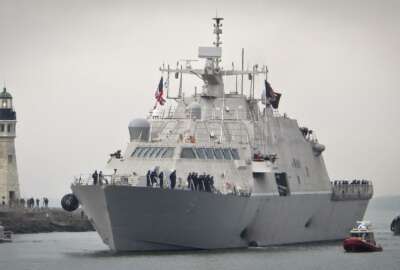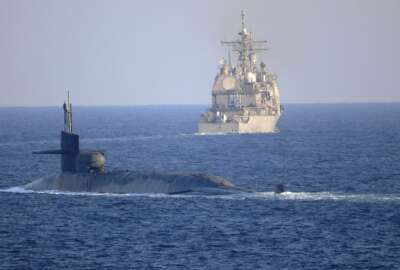Senate committee wants to add $35B to the Biden administration’s 2022 defense spending proposal
The Senate Armed Services Committee has issued its version of a defense policy bill for 2022, which would add $35 billion to what the Biden administration proposed.
Best listening experience is on Chrome, Firefox or Safari. Subscribe to Federal Drive’s daily audio interviews on Apple Podcasts or PodcastOne.
The Senate Armed Services Committee has issued its version of a defense policy bill for 2022. To nearly everyone’s surprise, it would add $35 billion to what the Biden administration has proposed. For more about this and what else is in there, Federal Drive with Tom Temin turned to senior adviser in the national security program at the Center for Strategic and International Studies, Mark Cancian.
Interview transcript:
Tom Temin: Mr. Cancian, good to have you back.
Mark Cancian: Well, thanks for having me on the show.
Tom Temin: Fair to say you were surprised by that $35 billion proposed plus-up over what the administration had proposed?
Mark Cancian: I was. I suspected that the Senate might come in higher. The Senate tends to be more deficit hawkish than the house. It also doesn’t have the Progressive Caucus that the house has to contend with, but that was a big number. Now, it may just be the beginning of a negotiation, so that with the House coming in at the President’s level, the Senate coming in at a much higher level, you’ll have a compromise somewhere in the middle. But that still increases the amount of money available to DoD quite substantially.
Tom Temin: Because you said the senate tends to be more deficit hawkish, are they perhaps more national defense hawkish also?
Mark Cancian: Defense hawkish, yes.
Tom Temin: Okay, and so you’d almost think Scoop Jackson is still around by this plus up.
Mark Cancian: Well, really. And there are a number of defense hawks in the Senate, and the Senate also tends to be more centrist. So you tend to see more concern about national security.
Tom Temin: Well, that’s the politics of it. In that $35 billion, what is it that would be purchased with the plus up, should it come to pass?
Mark Cancian: They’ve described a large number of things that they would plus up. It’s mostly procurements, although there were elements of everything else, you know, ONM operations and some maintenance, some benefits, some R&D. But lots of procurement programs were cut. The total amount of procurement was cut in the President’s budget proposal. So the Senate is essentially putting those elements back in, in lots of little pieces. Adding a few more aircrafts here, a few more aircrafts there. One of the big things that people have noted is that it puts a second destroyer back in the budget. The Navy had cut the destroyer. Typically it has funded two destroyers a year. It proposed cutting back to one. The Senate came back and put that second one in. And the House is putting that second destroyer in, too. And in fact, the house expressed some annoyance that this looked like a budget ploy by the Navy to get more money. But the biggest thing also is that the Senate funded essentially the service funded requirements listing. Every year, the services send in a list of what they call their unfunded requirements — that is, things that they would like to get into the budgets that they were not able to get in — and the senate took those as a basis and essentially funded those.
Tom Temin: And of course, there’s no overseas contingency operations funds this year proposed, and that leaves them less places to hide, I guess, too. Correct?
Mark Cancian: Well, the interesting thing is that they folded the war funding — the overseas contingency operations funding — directly into the budget, really, without any cuts. So DoD came through this process unscathed, which was a little unexpected, also, but good for the department.
Tom Temin: We’re speaking with Mark Cancian, he’s senior advisor in the national security program at the Center for Strategic and International Studies. And beyond the plus up, what were some of the other noteworthy provisions that you found, again, in the senate NDAA draft, as it stands now?
Mark Cancian: There were quite a number of interesting items that popped up. One is about retirement of older systems. The department has talked about getting rid of legacy systems. The Senate and the House also have prohibited the Airforce from making many of the retirements that they had proposed. But they’re allowing the Navy to go ahead with early retirements of some of its cruisers and LCS destroyers. So that was interesting. They sort of, the department got half of what they wanted there. Couple of other interesting things: they created a commission on the national defense strategy. Now, Congress has created such a commission with every administration basically, to provide an outside independent assessment of national security and its needs. Typically, those commissions have come in pretty hawkish with suggesting additional funds. And the listeners may be aware back during the early Trump years, the department, the Secretary and the chairman said that DoD needed 3% to 5% real growth every year to maintain its forces and modernize. Of course, the budget doesn’t provide for that. The Senate seems to be moving in that direction. And I think the commission will probably come out there, although of course it hasn’t even been named yet. There’s another commission on budget reform, which is interesting for insiders, probably not generally interesting. Couple of other things regarding women. One thing is that there’s been proposals to take sexual assault crimes away from commanders and put them in a special prosecutor. The concern had been that commanders were not being aggressive enough. That senate bill would do that. And the department has accepted that. I mean, the commanders are not really comfortable with it, but they have accepted that. Another interesting thing that’s got a lot of attention is the registration of women for the draft. The current draft law requires that only men register. In fact, the Supreme Court upheld that. Sort of as a surprise, at least to me, the Senate would require women to register. And, you know, that certainly seems to make a lot of sense now that all jobs are open to women. There doesn’t seem to be any good rationale for excluding women. Well, another thing that’s sort of interesting is that they continue support to the Afghan government. There have been a lot of concern that, you know, when the U.S. pulled out its forces that we would also end support to the Afghan government, really wash our hands of the whole thing, as we did in Vietnam in the 1970s. But the Senate proposes to continue that support.
Tom Temin: So lots of policy, lots of budgetary surprises in there. What about the House version? We’re starting to see the outline of what they would like to do.
Mark Cancian: We are. The biggest difference is that they are marking to the president’s budget level. So all of these additions that you see on the Senate side —these budget additions, procurement additions — you don’t see on the House side, for the most part. I mean, the House does a little moving around. They do add that second destroyer, as I mentioned. They are supporting more protections for women who are victims of sexual assault. They’re supporting a number of personnel benefits enhancements. There’s one called basic needs allowance, which would basically give additional money to juniors enlisted who have large families. They’re supporting, you know, this war funding change, which I think has broad bipartisan support. So you’re seeing some of the same things, but this huge difference on the amount of money.
Tom Temin: And the final question with respect to the whole ball of wax. The pivot to China, or the pivot to Asia, that was first delineated during the Obama administration, and I think at least verbally picked up again now by the Biden administration. Does the budget reflect that priority of great powers competition with China?
Mark Cancian: To the extent that it supports what the Biden administration has proposed, It does. I think it also maintains a broader set of capabilities than many strategists would argue for. And the higher budget level that the Senate is proposing allows that. That is, some strategists would say radically cut the forces, put that money into advanced weaponry and the kind of capabilities that would be useful against China. Other people, and I have to say myself included, say the United States needs to maintain a portfolio of capabilities, because our next conflict will probably not be against China. It will probably be someplace that we don’t even imagine today. And we need to maintain that spectrum of capabilities. You’re seeing that in the Senate version, although the extra money helps do both.
Tom Temin: And with respect to end strength in terms of numbers of troops, nothing radical one way or the other, then?
Mark Cancian: No, they came in at essentially the same level as the Biden administration had proposed. So what this means is that they are not increasing the size of the forces. The Senate is putting the money into primarily procurement, but also some of these other elements. Increased benefits, a little increase in R&D, which the Bisden demonstration had already increased.
Tom Temin: Alright, well, anything else we need to cover here?
Mark Cancian: They do create an Arctic deterrence initiative, which is sort of interesting. There’s been a lot of interest in the Arctic. DoD has created an Arctic strategy in response to what the Russians are doing up there and what the Chinese might potentially do. There’s already a European deterrence initiative and an Indo-Pacific deterrence initiative. They’ve added an Arctic detterence initiative to focus attention on that,
Tom Temin: And I guess they’ll get some more icebreakers. Are any of those in the budget?
Mark Cancian: The proposal is to build six: three heavy, three medium. And those are being built, and this Arctic deterrence initiative would help do that. Now, the icebreakers are in the Coast Guard budget. You know, the Navy provides some technical support, but it’s in the Coast Guard budget. And that program is continuing along. So yes, I would see that as continuing us adding icebreakers, but also a variety of capabilities that would be used in the far north. Beefing up facilities and capabilities in Alaska, for example. And you know, some of our early warning systems up in the far north,
Tom Temin: And who knows with what’s happening on the climate, maybe they need a slush breaker instead of an icebreaker.
Mark Cancian: Well, of course, you know, there’s more open water up in the north, and that’s creating increased activity, both civilian and military. One of the Coast Guard’s nightmares is that a civilian cruise liner gets in trouble up in the far north, and we just don’t have the capability to go and help it.
Tom Temin: Yeah, alright. We’ll think twice about booking one of those. Mark Cancian is senior advisor in the national security program at the Center for Strategic and International Studies. Thanks so much.
Mark Cancian: Glad to join you.
Copyright © 2025 Federal News Network. All rights reserved. This website is not intended for users located within the European Economic Area.
Tom Temin is host of the Federal Drive and has been providing insight on federal technology and management issues for more than 30 years.
Follow @tteminWFED







